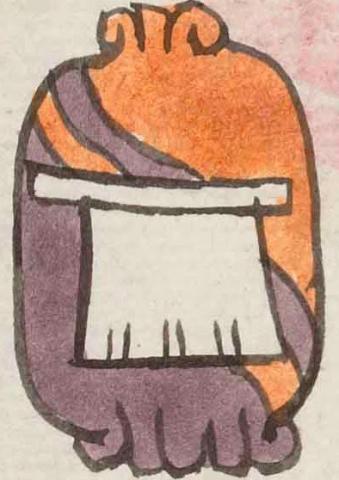Tequemecan (Mdz20r)
This compound glyph for the place name Tequemecan includes two components, a stone (tetl) and a ritual chest garment (quemitl). The locative suffix -can is not shown visually. The tetl in this case is largely vertical, with its curling ends at the top and bottom. It has the typical alternating, wavy purple and orange coloring. The quemitl is white, trapezoidal, and has a tie along the top line. The bottom edge appears to be fringed somewhat. It may be cloth or paper.
Stephanie Wood
Sometimes a quemitl comprises feathers, but this one appears to be white cotton cloth or paper. The fact that we have two examples whereby the quemitl covers a face and a rock suggests that the quemitl could be used for more than a chest garment. It could be a covering.
Stephanie Wood
tequemecan. puo
Tequemecan, pueblo
Stephanie Wood
c. 1541, or by 1553 at the latest
Stephanie Wood
ritual bibs, ritual garments, nombres de lugares

te(tl), stone or rock, https://nahuatl.wired-humanities.org/content/tetl
quemi(tl), a ritual bib, a garment, https://nahuatl.wired-humanities.org/content/quemitl
-can (locative suffix), https://nahuatl.wired-humanities.org/content/can-2
Codex Mendoza, folio 20 recto, https://digital.bodleian.ox.ac.uk/objects/2fea788e-2aa2-4f08-b6d9-648c00..., image 50 of 188.
The Bodleian Libraries, University of Oxford, hold the original manuscript, the MS. Arch. Selden. A. 1. This image is published here under the UK Creative Commons, “Attribution-NonCommercial-ShareAlike 3.0 License” (CC-BY-NC-SA 3.0).




